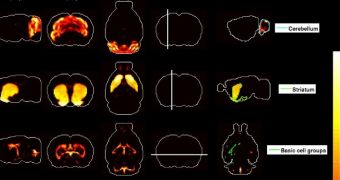A group of investigators with the Cold Spring Harbor Laboratory (CSHL) announces the development of a new technique for predicting where specific types of neurons are located within the human brain. Their approach is based on a new mathematical model that is able to browse through massive datasets to come up with relevant predictions.
Scientists with the group say that analyzing the identity of people can reveal a lot about where they live. Elements related to identity in this case include the type of food they eat, the jobs they do, the types of cars they drive, and so on. Similarly, knowing a lot about the identity of neurons can now help scientists figure out where these nerve cells are located.
Some of the most important things defining neurons are the gene activation patterns they use. Experts say that similar nerve cells tend to live together in distinct brain regions. However, until now, researchers have found it difficult to fully map the extent and inner structures of these regions, which is where the new approach comes in.
In a paper published in the March 24 issue of the esteemed journal Proceedings of the National Academy of Sciences (PNAS), CSHL experts describe how they worked together with colleagues at the Allen Institute for Brain Science in Seattle to combine large datasets about neural types into a mathematical model that can predict neuron locations based on molecular identities.
AIBS researchers are the team behind the Allen Mouse Brain Atlas, a collection of brain maps obtained by studying genetic activity in very thin slices of mouse brain tissue. What these maps reveal is the location where single genes are expressed in the brain. Patterns can be obtained when multiple maps are overlaid, the team explains.
Studies have thus far revealed that different regions of the brain activate not one, but a full complement of genes, in a type of association called the co-expression profile. In other researches, scientists have taken single neurons, and checked to see which genes were expressed within.
CSHL Professor Partha Mitra, the leader of the research, and postdoctoral research fellow Pascal Grange, PhD, integrated the two types of datasets via a mathematical model. “Our model is simple, but it has predictive power. If the gene expression profile of a neuronal type is measured, then the model predicts where in the brain that type of neuron can be found,” Mitra explains.
The model also “enables us to now have a biological understanding of the patterns, the co-expression profiles, seen in the Allen Gene Expression Atlas of the Mouse Brain,” Grance adds.

 14 DAY TRIAL //
14 DAY TRIAL //